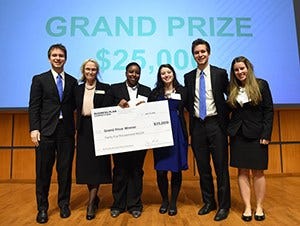Student Startup Builds ‘Bubbles’ to Deliver Cancer Drugs
 Certus won $25
Certus won $25
Subscriber Benefit
As a subscriber you can listen to articles at work, in the car, or while you work out. Subscribe NowA student-run startup at the University of Notre Dame is generating buzz among pharmaceutical companies searching for better ways to deliver cancer-fighting drugs. Certus Therapeutics, which recently captured the top prize at the university’s annual McCloskey Business Plan Competition, says its technology could greatly reduce the toxic effects of chemotherapy and other cancer treatments. The young company hasn’t discovered a drug, but rather, a novel delivery method for existing medications that could prevent cancer patients from feeling even sicker.
Patients who have cancer typically experience negative side effects during chemotherapy because the drug—which aims to stop the growth of cancer cells—can also harm healthy cells; it can’t discriminate between healthy and cancerous tissue.
But these two types of tissue are very different in structure, says Certus. Based on discoveries made in the lab of Notre Dame Chemical and Biomolecular Engineer Dr. Basar Bilgicer, the concept is surprisingly simple.
“The gaps between cells in healthy body tissues and healthy blood vessels are very, very small, but when a tumor starts to form, it doesn’t form properly,” says Notre Dame Integrated Biomedical Sciences graduate student Charissa Quinlan, who is on the student team leading Certus. “The gaps that are between the cells in the vessel wall [of a tumor] are around 100 times larger, so there’s a huge size difference that only happens where the cancer is.”
Certus’ technology exploits that size difference, blocking the drug from penetrating healthy tissue.
“We aim to take that same small molecule drug that cancer patients are already receiving, and essentially, put it in this little bubble. So now, this bubble is bigger than the drug itself,” says Quinlan. “As a result, it can only fit through where the cancer has formed; it can’t go through your healthy tissue and healthy organs. We size our bubbles—or our particles—specifically so they’re too big to fit through the healthy spot, but small enough to get through where the cancer has formed.”
Certus says it delivers a one-two punch by also putting a molecule—specific to the patient’s particular cancer—on the surface of the bubbles. Quinlan says this makes the method “even more targeted to ensure we’re getting into each of those cancer cells” once the bubbles are in the general tumor area.
The bubbles, which Certus has named Lypos, are customizable for a variety of drugs for the many different types of cancer. While Quinlan acknowledges this was the most challenging aspect of creating Lypos, having a basic technology that could be customized was a priority from the beginning, “so we weren’t having to reinvent the wheel with every single type of cancer.”
“We’re wanting to work with existing pharmaceutical companies,” says Quinlan. “We would make them a nanoparticle formulation specific to their drug and their application, then we hand it back to them to go through clinical trials, because that’s what their expertise is.”
Certus won $25,000 at the McCloskey competition and is now in the early stages of raising money. Senior Innovation Officer for the Cleveland Clinic and Tech Transfer at Notre Dame Gaylene Anderson says the startup is already generating interest from small to large pharmaceutical companies.
“I think the feedback from judges is good customer validation to see what the appetite is like with investors for a company like this,” says Anderson. “It’s good for the inventors to go through this as well. Often the university inventors have no experience writing a business plan or putting together a pitch.”
Quinlan, who is pursuing her PhD, says the exposure to the “business side” of science altered her career plans; she’ll be putting her doctorate on hold while she leads the charge to commercialize Certus’ technology.
“From a scientist’s viewpoint, the money side of things is kind of considered the dirty back room; it was really great to gain an appreciation for the [business side] and understand the intricacies of how difficult it really is to push something from the lab to the clinic—despite how revolutionary it could be,” says Quinlan. “For it to no longer be an academic exercise, I think that’s the most exciting thing right now. Watching it really come to life is thrilling.”
While the bubbles represent “passive targeting,” Quinlan says the technology has a second layer of “active” targeting.
Quinlan says “the fun part of the puzzle” is customizing Certus’ basic technology for different cancers and drugs.
